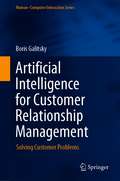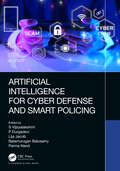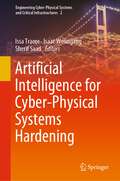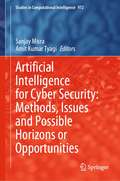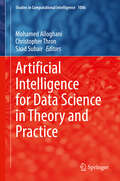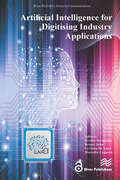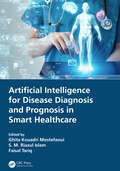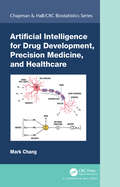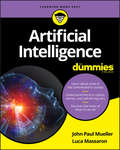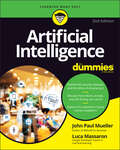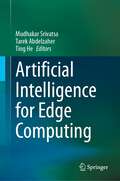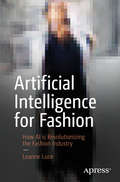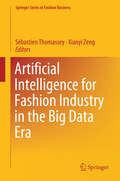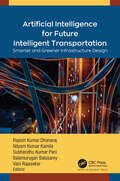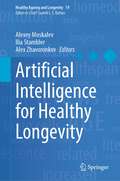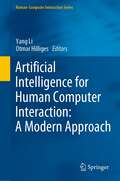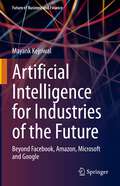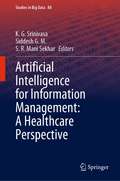- Table View
- List View
Artificial Intelligence for Customer Relationship Management: Solving Customer Problems (Human–Computer Interaction Series)
by Boris GalitskyThe second volume of this research monograph describes a number of applications of Artificial Intelligence in the field of Customer Relationship Management with the focus of solving customer problems. We design a system that tries to understand the customer complaint, his mood, and what can be done to resolve an issue with the product or service. To solve a customer problem efficiently, we maintain a dialogue with the customer so that the problem can be clarified and multiple ways to fix it can be sought. We introduce dialogue management based on discourse analysis: a systematic linguistic way to handle the thought process of the author of the content to be delivered. We analyze user sentiments and personal traits to tailor dialogue management to individual customers. We also design a number of dialogue scenarios for CRM with replies following certain patterns and propose virtual and social dialogues for various modalities of communication with a customer. After we learn to detect fake content, deception and hypocrisy, we examine the domain of customer complaints. We simulate mental states, attitudes and emotions of a complainant and try to predict his behavior. Having suggested graph-based formal representations of complaint scenarios, we machine-learn them to identify the best action the customer support organization can chose to retain the complainant as a customer.
Artificial Intelligence for Cyber Defense and Smart Policing
by S. Vijayalakshmi, P. Durgadevi, Lija Jacob, Balamurugan Balusamy, and Parma NandThe future policing ought to cover identification of new assaults, disclosure of new ill-disposed patterns, and forecast of any future vindictive patterns from accessible authentic information. Such keen information will bring about building clever advanced proof handling frameworks that will help cops investigate violations. Artificial Intelligence for Cyber Defense and Smart Policing will describe the best way of practicing artificial intelligence for cyber defense and smart policing.Salient Features:• Combines AI for both cyber defense and smart policing in one place.• Covers novel strategies in future to help cybercrime examinations and police.• Discusses different AI models to fabricate more exact techniques.• Elaborates on problematization and international issues.• Includes case studies and real-life examples.This book is primarily aimed at graduates, researchers, and IT professionals. Business executives will also find this book helpful.
Artificial Intelligence for Cyber Defense and Smart Policing
The future policing ought to cover identification of new assaults, disclosure of new ill-disposed patterns, and forecast of any future vindictive patterns from accessible authentic information. Such keen information will bring about building clever advanced proof handling frameworks that will help cops investigate violations. Artificial Intelligence for Cyber Defense and Smart Policing will describe the best way of practicing artificial intelligence for cyber defense and smart policing.Salient Features:• Combines AI for both cyber defense and smart policing in one place.• Covers novel strategies in future to help cybercrime examinations and police.• Discusses different AI models to fabricate more exact techniques.• Elaborates on problematization and international issues.• Includes case studies and real-life examples.This book is primarily aimed at graduates, researchers, and IT professionals. Business executives will also find this book helpful.
Artificial Intelligence for Cyber-Physical Systems Hardening (Engineering Cyber-Physical Systems and Critical Infrastructures #2)
by Issa Traore Isaac Woungang Sherif SaadThis book presents advances in security assurance for cyber-physical systems (CPS) and report on new machine learning (ML) and artificial intelligence (AI) approaches and technologies developed by the research community and the industry to address the challenges faced by this emerging field. Cyber-physical systems bridge the divide between cyber and physical-mechanical systems by combining seamlessly software systems, sensors, and actuators connected over computer networks. Through these sensors, data about the physical world can be captured and used for smart autonomous decision-making. This book introduces fundamental AI/ML principles and concepts applied in developing secure and trustworthy CPS, disseminates recent research and development efforts in this fascinating area, and presents relevant case studies, examples, and datasets. We believe that it is a valuable reference for students, instructors, researchers, industry practitioners, and related government agencies staff.
Artificial Intelligence for Cyber Security: Methods, Issues and Possible Horizons or Opportunities (Studies in Computational Intelligence #972)
by Sanjay Misra Amit Kumar TyagiThis book provides stepwise discussion, exhaustive literature review, detailed analysis and discussion, rigorous experimentation results (using several analytics tools), and an application-oriented approach that can be demonstrated with respect to data analytics using artificial intelligence to make systems stronger (i.e., impossible to breach). We can see many serious cyber breaches on Government databases or public profiles at online social networking in the recent decade. Today artificial intelligence or machine learning is redefining every aspect of cyber security. From improving organizations’ ability to anticipate and thwart breaches, protecting the proliferating number of threat surfaces with Zero Trust Security frameworks to making passwords obsolete, AI and machine learning are essential to securing the perimeters of any business. The book is useful for researchers, academics, industry players, data engineers, data scientists, governmental organizations, and non-governmental organizations.
Artificial Intelligence for Data Science in Theory and Practice (Studies in Computational Intelligence #1006)
by Mohamed Alloghani Christopher Thron Saad SubairThis book provides valuable information on effective, state-of-the-art techniques and approaches for governments, students, researchers, practitioners, entrepreneurs and teachers in the field of artificial intelligence (AI). The book explains the data and AI, types and properties of data, the relation between AI algorithms and data, what makes data AI ready, steps of data pre-processing, data quality, data storage and data platforms. Therefore, this book will be interested by AI practitioners, academics, researchers, and lecturers in computer science, artificial intelligence, machine learning and data sciences.
Artificial Intelligence for Digitising Industry – Applications
by Ovidiu Vermesan Reiner John Cristina De Luca Marcello CoppolaThis book provides in-depth insights into use cases implementing artificial intelligence (AI) applications at the edge. It covers new ideas, concepts, research, and innovation to enable the development and deployment of AI, the industrial internet of things (IIoT), edge computing, and digital twin technologies in industrial environments. The work is based on the research results and activities of the AI4DI project, including an overview of industrial use cases, research, technological innovation, validation, and deployment. This book’s sections build on the research, development, and innovative ideas elaborated for applications in five industries: automotive, semiconductor, industrial machinery, food and beverage, and transportation. The articles included under each of these five industrial sectors discuss AI-based methods, techniques, models, algorithms, and supporting technologies, such as IIoT, edge computing, digital twins, collaborative robots, silicon-born AI circuit concepts, neuromorphic architectures, and augmented intelligence, that are anticipating the development of Industry 5.0. Automotive applications cover use cases addressing AI-based solutions for inbound logistics and assembly process optimisation, autonomous reconfigurable battery systems, virtual AI training platforms for robot learning, autonomous mobile robotic agents, and predictive maintenance for machines on the level of a digital twin. AI-based technologies and applications in the semiconductor manufacturing industry address use cases related to AI-based failure modes and effects analysis assistants, neural networks for predicting critical 3D dimensions in MEMS inertial sensors, machine vision systems developed in the wafer inspection production line, semiconductor wafer fault classifications, automatic inspection of scanning electron microscope cross-section images for technology verification, anomaly detection on wire bond process trace data, and optical inspection. The use cases presented for machinery and industrial equipment industry applications cover topics related to wood machinery, with the perception of the surrounding environment and intelligent robot applications. AI, IIoT, and robotics solutions are highlighted for the food and beverage industry, presenting use cases addressing novel AI-based environmental monitoring; autonomous environment-aware, quality control systems for Champagne production; and production process optimisation and predictive maintenance for soybeans manufacturing. For the transportation sector, the use cases presented cover the mobility-as-a-service development of AI-based fleet management for supporting multimodal transport. This book highlights the significant technological challenges that AI application developments in industrial sectors are facing, presenting several research challenges and open issues that should guide future development for evolution towards an environment-friendly Industry 5.0. The challenges presented for AI-based applications in industrial environments include issues related to complexity, multidisciplinary and heterogeneity, convergence of AI with other technologies, energy consumption and efficiency, knowledge acquisition, reasoning with limited data, fusion of heterogeneous data, availability of reliable data sets, verification, validation, and testing for decision-making processes.
Artificial Intelligence for Digitising Industry – Applications
This book provides in-depth insights into use cases implementing artificial intelligence (AI) applications at the edge. It covers new ideas, concepts, research, and innovation to enable the development and deployment of AI, the industrial internet of things (IIoT), edge computing, and digital twin technologies in industrial environments. The work is based on the research results and activities of the AI4DI project, including an overview of industrial use cases, research, technological innovation, validation, and deployment. This book’s sections build on the research, development, and innovative ideas elaborated for applications in five industries: automotive, semiconductor, industrial machinery, food and beverage, and transportation. The articles included under each of these five industrial sectors discuss AI-based methods, techniques, models, algorithms, and supporting technologies, such as IIoT, edge computing, digital twins, collaborative robots, silicon-born AI circuit concepts, neuromorphic architectures, and augmented intelligence, that are anticipating the development of Industry 5.0. Automotive applications cover use cases addressing AI-based solutions for inbound logistics and assembly process optimisation, autonomous reconfigurable battery systems, virtual AI training platforms for robot learning, autonomous mobile robotic agents, and predictive maintenance for machines on the level of a digital twin. AI-based technologies and applications in the semiconductor manufacturing industry address use cases related to AI-based failure modes and effects analysis assistants, neural networks for predicting critical 3D dimensions in MEMS inertial sensors, machine vision systems developed in the wafer inspection production line, semiconductor wafer fault classifications, automatic inspection of scanning electron microscope cross-section images for technology verification, anomaly detection on wire bond process trace data, and optical inspection. The use cases presented for machinery and industrial equipment industry applications cover topics related to wood machinery, with the perception of the surrounding environment and intelligent robot applications. AI, IIoT, and robotics solutions are highlighted for the food and beverage industry, presenting use cases addressing novel AI-based environmental monitoring; autonomous environment-aware, quality control systems for Champagne production; and production process optimisation and predictive maintenance for soybeans manufacturing. For the transportation sector, the use cases presented cover the mobility-as-a-service development of AI-based fleet management for supporting multimodal transport. This book highlights the significant technological challenges that AI application developments in industrial sectors are facing, presenting several research challenges and open issues that should guide future development for evolution towards an environment-friendly Industry 5.0. The challenges presented for AI-based applications in industrial environments include issues related to complexity, multidisciplinary and heterogeneity, convergence of AI with other technologies, energy consumption and efficiency, knowledge acquisition, reasoning with limited data, fusion of heterogeneous data, availability of reliable data sets, verification, validation, and testing for decision-making processes.
Artificial Intelligence for Disease Diagnosis and Prognosis in Smart Healthcare
by Ghita Kouadri Mostefaoui Islam, S. M. Riazul Faisal TariqArtificial Intelligence (AI) in general and machine learning (ML) and deep learning (DL) in particular and related digital technologies are a couple of fledging paradigms that next-generation healthcare services are sprinting towards. These digital technologies can transform various aspects of healthcare, leveraging advances in computing and communication power. With a new spectrum of business opportunities, AI-powered healthcare services will improve the lives of patients, their families, and societies. However, the application of AI in the healthcare field requires special attention given the direct implication with human life and well-being. Rapid progress in AI leads to the possibility of exploiting healthcare data for designing practical tools for automated diagnosis of chronic diseases such as dementia and diabetes. This book highlights the current research trends in applying AI models in various disease diagnoses and prognoses to provide enhanced healthcare solutions. The primary audience of the book are postgraduate students and researchers in the broad domain of healthcare technologies. Features In-depth coverage of the role of AI in smart healthcare Research guidelines for AI and data science researchers/practitioners interested in the healthcare sector Comprehensive coverage on security and privacy issues for AI in smart healthcare
Artificial Intelligence for Disease Diagnosis and Prognosis in Smart Healthcare
by Ghita Kouadri Mostefaoui S. M. Riazul Islam Faisal TariqArtificial Intelligence (AI) in general and machine learning (ML) and deep learning (DL) in particular and related digital technologies are a couple of fledging paradigms that next-generation healthcare services are sprinting towards. These digital technologies can transform various aspects of healthcare, leveraging advances in computing and communication power. With a new spectrum of business opportunities, AI-powered healthcare services will improve the lives of patients, their families, and societies. However, the application of AI in the healthcare field requires special attention given the direct implication with human life and well-being. Rapid progress in AI leads to the possibility of exploiting healthcare data for designing practical tools for automated diagnosis of chronic diseases such as dementia and diabetes. This book highlights the current research trends in applying AI models in various disease diagnoses and prognoses to provide enhanced healthcare solutions. The primary audience of the book are postgraduate students and researchers in the broad domain of healthcare technologies. Features In-depth coverage of the role of AI in smart healthcare Research guidelines for AI and data science researchers/practitioners interested in the healthcare sector Comprehensive coverage on security and privacy issues for AI in smart healthcare
Artificial Intelligence for Drug Development, Precision Medicine, and Healthcare (Chapman & Hall/CRC Biostatistics Series)
by Mark ChangArtificial Intelligence for Drug Development, Precision Medicine, and Healthcare covers exciting developments at the intersection of computer science and statistics. While much of machine-learning is statistics-based, achievements in deep learning for image and language processing rely on computer science&’s use of big data. Aimed at those with a statistical background who want to use their strengths in pursuing AI research, the book: · Covers broad AI topics in drug development, precision medicine, and healthcare. · Elaborates on supervised, unsupervised, reinforcement, and evolutionary learning methods. · Introduces the similarity principle and related AI methods for both big and small data problems. · Offers a balance of statistical and algorithm-based approaches to AI. · Provides examples and real-world applications with hands-on R code. · Suggests the path forward for AI in medicine and artificial general intelligence. As well as covering the history of AI and the innovative ideas, methodologies and software implementation of the field, the book offers a comprehensive review of AI applications in medical sciences. In addition, readers will benefit from hands on exercises, with included R code.
Artificial Intelligence for Drug Development, Precision Medicine, and Healthcare (Chapman & Hall/CRC Biostatistics Series)
by Mark ChangArtificial Intelligence for Drug Development, Precision Medicine, and Healthcare covers exciting developments at the intersection of computer science and statistics. While much of machine-learning is statistics-based, achievements in deep learning for image and language processing rely on computer science&’s use of big data. Aimed at those with a statistical background who want to use their strengths in pursuing AI research, the book: · Covers broad AI topics in drug development, precision medicine, and healthcare. · Elaborates on supervised, unsupervised, reinforcement, and evolutionary learning methods. · Introduces the similarity principle and related AI methods for both big and small data problems. · Offers a balance of statistical and algorithm-based approaches to AI. · Provides examples and real-world applications with hands-on R code. · Suggests the path forward for AI in medicine and artificial general intelligence. As well as covering the history of AI and the innovative ideas, methodologies and software implementation of the field, the book offers a comprehensive review of AI applications in medical sciences. In addition, readers will benefit from hands on exercises, with included R code.
Artificial Intelligence For Dummies
by John Paul Mueller Luca MassaronStep into the future with AI The term "Artificial Intelligence" has been around since the 1950s, but a lot has changed since then. Today, AI is referenced in the news, books, movies, and TV shows, and the exact definition is often misinterpreted. Artificial Intelligence For Dummies provides a clear introduction to AI and how it’s being used today. Inside, you’ll get a clear overview of the technology, the common misconceptions surrounding it, and a fascinating look at its applications in everything from self-driving cars and drones to its contributions in the medical field. Learn about what AI has contributed to society Explore uses for AI in computer applications Discover the limits of what AI can do Find out about the history of AI The world of AI is fascinating—and this hands-on guide makes it more accessible than ever!
Artificial Intelligence For Dummies
by John Paul Mueller Luca MassaronStep into the future with AI The term "Artificial Intelligence" has been around since the 1950s, but a lot has changed since then. Today, AI is referenced in the news, books, movies, and TV shows, and the exact definition is often misinterpreted. Artificial Intelligence For Dummies provides a clear introduction to AI and how it’s being used today. Inside, you’ll get a clear overview of the technology, the common misconceptions surrounding it, and a fascinating look at its applications in everything from self-driving cars and drones to its contributions in the medical field. Learn about what AI has contributed to society Explore uses for AI in computer applications Discover the limits of what AI can do Find out about the history of AI The world of AI is fascinating—and this hands-on guide makes it more accessible than ever!
Artificial Intelligence For Dummies
by John Paul Mueller Luca MassaronForget far-away dreams of the future. Artificial intelligence is here now! Every time you use a smart device or some sort of slick technology—be it a smartwatch, smart speaker, security alarm, or even customer service chat box—you’re engaging with artificial intelligence (AI). If you’re curious about how AI is developed—or question whether AI is real—Artificial Intelligence For Dummies holds the answers you’re looking for. Starting with a basic definition of AI and explanations of data use, algorithms, special hardware, and more, this reference simplifies this complex topic for anyone who wants to understand what operates the devices we can’t live without. This book will help you: Separate the reality of artificial intelligence from the hype Know what artificial intelligence can accomplish and what its limits are Understand how AI speeds up data gathering and analysis to help you make informed decisions more quickly See how AI is being used in hardware applications like drones, robots, and vehicles Know where AI could be used in space, medicine, and communication fields sooner than you think Almost 80 percent of the devices you interact with every day depend on some sort of AI. And although you don’t need to understand AI to operate your smart speaker or interact with a bot, you’ll feel a little smarter—dare we say more intelligent—when you know what’s going on behind the scenes. So don’t wait. Pick up this popular guide to unlock the secrets of AI today!
Artificial Intelligence For Dummies
by John Paul Mueller Luca MassaronForget far-away dreams of the future. Artificial intelligence is here now! Every time you use a smart device or some sort of slick technology—be it a smartwatch, smart speaker, security alarm, or even customer service chat box—you’re engaging with artificial intelligence (AI). If you’re curious about how AI is developed—or question whether AI is real—Artificial Intelligence For Dummies holds the answers you’re looking for. Starting with a basic definition of AI and explanations of data use, algorithms, special hardware, and more, this reference simplifies this complex topic for anyone who wants to understand what operates the devices we can’t live without. This book will help you: Separate the reality of artificial intelligence from the hype Know what artificial intelligence can accomplish and what its limits are Understand how AI speeds up data gathering and analysis to help you make informed decisions more quickly See how AI is being used in hardware applications like drones, robots, and vehicles Know where AI could be used in space, medicine, and communication fields sooner than you think Almost 80 percent of the devices you interact with every day depend on some sort of AI. And although you don’t need to understand AI to operate your smart speaker or interact with a bot, you’ll feel a little smarter—dare we say more intelligent—when you know what’s going on behind the scenes. So don’t wait. Pick up this popular guide to unlock the secrets of AI today!
Artificial Intelligence for Edge Computing
by Mudhakar Srivatsa Tarek Abdelzaher Ting HeIt is undeniable that the recent revival of artificial intelligence (AI) has significantly changed the landscape of science in many application domains, ranging from health to defense and from conversational interfaces to autonomous cars. With terms such as “Google Home”, “Alexa”, and “ChatGPT” becoming household names, the pervasive societal impact of AI is clear. Advances in AI promise a revolution in our interaction with the physical world, a domain where computational intelligence has always been envisioned as a transformative force toward a better tomorrow. Depending on the application family, this domain is often referred to as Ubiquitous Computing, Cyber-Physical Computing, or the Internet of Things. The underlying vision is driven by the proliferation of cheap embedded computing hardware that can be integrated easily into myriads of everyday devices from consumer electronics, such as personal wearables and smart household appliances, to city infrastructure and industrial process control systems. One common trait across these applications is that the data that the application operates on come directly (typically via sensors) from the physical world. Thus, from the perspective of communication network infrastructure, the data originate at the network edge. From a performance standpoint, there is an argument to be made that such data should be processed at the point of collection. Hence, a need arises for Edge AI -- a genre of AI where the inference, and sometimes even the training, are performed at the point of need, meaning at the edge where the data originate. The book is broken down into three parts: core problems, distributed problems, and other cross-cutting issues. It explores the challenges arising in Edge AI contexts. Some of these challenges (such as neural network model reduction to fit resource-constrained hardware) are unique to the edge environment. They need a novel category of solutions that do not parallel more typical concerns in mainstream AI. Others are adaptations of mainstream AI challenges to the edge space. An example is overcoming the cost of data labeling. The labeling problem is pervasive, but its solution in the IoT application context is different from other contexts. This book is not a survey of the state of the art. With thousands of publications appearing in AI every year, such a survey is doomed to be incomplete on arrival. It is also not a comprehensive coverage of all the problems in the space of Edge AI. Different applications pose different challenges, and a more comprehensive coverage should be more application specific. Instead, this book covers some of the more endemic challenges across the range of IoT/CPS applications. To offer coverage in some depth, we opt to cover mainly one or a few representative solutions for each of these endemic challenges in sufficient detail, rather that broadly touching on all relevant prior work. The underlying philosophy is one of illustrating by example. The solutions are curated to offer insight into a way of thinking that characterizes Edge AI research and distinguishes its solutions from their more mainstream counterparts.
Artificial Intelligence for Fashion: How AI is Revolutionizing the Fashion Industry
by Leanne LuceLearn how Artificial Intelligence (AI) is being applied in the fashion industry. With an application focused approach, this book provides real-world examples, breaks down technical jargon for non-technical readers, and provides an educational resource for fashion professionals. The book investigates the ways in which AI is impacting every part of the fashion value chain starting with product discovery and working backwards to manufacturing. Artificial Intelligence for Fashion walks you through concepts, such as connected retail, data mining, and artificially intelligent robotics. Each chapter contains an example of how AI is being applied in the fashion industry illustrated by one major technological theme. There are no equations, algorithms, or code. The technological explanations are cumulative so you'll discover more information about the inner workings of artificial intelligence in practical stages as the book progresses. What You’ll LearnGain a basic understanding of AI and how it is used in fashionUnderstand key terminology and concepts in AIReview the new competitive landscape of the fashion industryConceptualize and develop new ways to apply AI within the workplaceWho This Book Is ForFashion industry professionals from designers, managers, department heads, and executives can use this book to learn about how AI is impacting roles in every department and profession.
Artificial Intelligence for Fashion Industry in the Big Data Era (Springer Series in Fashion Business)
by Sébastien Thomassey Xianyi ZengThis book provides an overview of current issues and challenges in the fashion industry and an update on data-driven artificial intelligence (AI) techniques and their potential implementation in response to those challenges. Each chapter starts off with an example of a data-driven AI technique on a particular sector of the fashion industry (design, manufacturing, supply or retailing), before moving on to illustrate its implementation in a real-world application
Artificial Intelligence for Future Intelligent Transportation: Smarter and Greener Infrastructure Design
by Rajesh Kumar Dhanaraj Nilayam Kumar Kamila Subhendu Kumar Pani Balamurugan Balusamy Vani RajasekarEmphasizing a sustainable and green approach, this new book presents an overview of state-of-the-art AI strategies for solving transportation challenges around the world, with a focus on traffic management, traffic safety, public transportation, urban mobility, and pollution mitigation. The book examines modern AI technologies such as IoT, cloud computing, machine learning, and neural networking in the context of fully automated transportation that meets current requirements. The volume provides an informative review of the difficulties and recent developments in smart mobility and transportation, encompassing technical, algorithmic, and social elements. The volume examines innovative service and platform concepts for future mobility. Artificial intelligence principles are examined as well as their implementation in modern hardware architecture. New machine learning issues for autonomous vehicles and fleets are investigated in the framework of artificial intelligence. In addition, the book investigates the human dynamics and social implications of future mobility concepts. Highlighting the research directions in this field, Artificial Intelligence for Future Intelligent Transportation: Smarter and Greener Infrastructure Design will be of value for researchers in cybersecurity, machine learning, data analysis, and artificial intelligence. Ethical hackers, students, and faculty will find useful information here as well.
Artificial Intelligence for Future Intelligent Transportation: Smarter and Greener Infrastructure Design
Emphasizing a sustainable and green approach, this new book presents an overview of state-of-the-art AI strategies for solving transportation challenges around the world, with a focus on traffic management, traffic safety, public transportation, urban mobility, and pollution mitigation. The book examines modern AI technologies such as IoT, cloud computing, machine learning, and neural networking in the context of fully automated transportation that meets current requirements. The volume provides an informative review of the difficulties and recent developments in smart mobility and transportation, encompassing technical, algorithmic, and social elements. The volume examines innovative service and platform concepts for future mobility. Artificial intelligence principles are examined as well as their implementation in modern hardware architecture. New machine learning issues for autonomous vehicles and fleets are investigated in the framework of artificial intelligence. In addition, the book investigates the human dynamics and social implications of future mobility concepts. Highlighting the research directions in this field, Artificial Intelligence for Future Intelligent Transportation: Smarter and Greener Infrastructure Design will be of value for researchers in cybersecurity, machine learning, data analysis, and artificial intelligence. Ethical hackers, students, and faculty will find useful information here as well.
Artificial Intelligence for Healthy Longevity (Healthy Ageing and Longevity #19)
by Alexey Moskalev Ilia Stambler Alex ZhavoronkovThis book reviews the state-of-the-art efforts to apply machine learning and AI methods for healthy aging and longevity research, diagnosis, and therapy development. The book examines the methods of machine learning and their application in the analysis of big medical data, medical images, the creation of algorithms for assessing biological age, and effectiveness of geroprotective medications.The promises and challenges of using AI to help achieve healthy longevity for the population are manifold. This volume, written by world-leading experts working at the intersection of AI and aging, provides a unique synergy of these two highly prominent fields and aims to create a balanced and comprehensive overview of the application methodology that can help achieve healthy longevity for the population.The book is accessible and valuable for specialists in AI and longevity research, as well as a wide readership, including gerontologists, geriatricians, medical specialists, and students from diverse fields, basic scientists, public and private research entities, and policy makers interested in potential intervention in degenerative aging processes using advanced computational tools.
Artificial Intelligence for Human Computer Interaction: A Modern Approach (Human–Computer Interaction Series)
by Yang Li Otmar HilligesThis edited book explores the many interesting questions that lie at the intersection between AI and HCI. It covers a comprehensive set of perspectives, methods and projects that present the challenges and opportunities that modern AI methods bring to HCI researchers and practitioners. The chapters take a clear departure from traditional HCI methods and leverage data-driven and deep learning methods to tackle HCI problems that were previously challenging or impossible to address.It starts with addressing classic HCI topics, including human behaviour modeling and input, and then dedicates a section to data and tools, two technical pillars of modern AI methods. These chapters exemplify how state-of-the-art deep learning methods infuse new directions and allow researchers to tackle long standing and newly emerging HCI problems alike. Artificial Intelligence for Human Computer Interaction: A Modern Approach concludes with a section on Specific Domains which covers a set of emerging HCI areas where modern AI methods start to show real impact, such as personalized medical, design, and UI automation.
Artificial Intelligence for Industries of the Future: Beyond Facebook, Amazon, Microsoft and Google (Future of Business and Finance)
by Mayank KejriwalThis book provides a brief synthesis of the known implementations, opportunities and challenges at the intersection of artificial intelligence (AI) and modern industry beyond the big-four companies that traditionally consume and produce such advanced technology: Facebook, Amazon, Microsoft and Google. With this information, the author also makes some reasonable claims about the role of AI in future industries. The book draws on a broad range of material, including reports from consulting firms, published surveys, academic papers and books, and expert knowledge available to the author due to numerous collaborations in academia and industry on AI. It is rigorous rather than speculative, drawing on known findings and expert summaries, where available. This provides industry leaders and other interested stakeholders with an accessible review of contemporary perspectives on AI’s forward-looking role in industry as well as a clarifying guide on the major issues that companies are likely to face as they commence on this exciting path.Examines the likely role of AI in industries of the future, both known and unknownPresents use-cases of AI currently being explored across Big Tech, multi-national corporations and start-upsExplores the regulation of AI and its potential impacts on the workforce
Artificial Intelligence for Information Management: A Healthcare Perspective (Studies in Big Data #88)
by K. G. Srinivasa Siddesh G. M. S. R. Mani SekharThis book discusses the advancements in artificial intelligent techniques used in the well-being of human healthcare. It details the techniques used in collection, storage and analysis of data and their usage in different healthcare solutions. It also discusses the techniques of predictive analysis in early diagnosis of critical diseases. The edited book is divided into four parts – part A discusses introduction to artificial intelligence and machine learning in healthcare; part B highlights different analytical techniques used in healthcare; part C provides various security and privacy mechanisms used in healthcare; and finally, part D exemplifies different tools used in visualization and data analytics.
